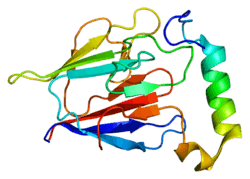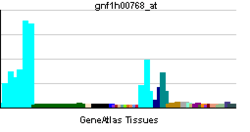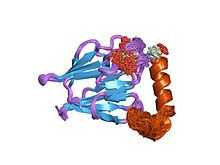MKI67IP
| FHA Ki67 binding domain of hNIFK |
|---|
|
the solution structure of the ki67fha/hnifk(226-269)3p complex |
| Identifiers |
|---|
| Symbol |
hNIFK_binding |
|---|
| Pfam |
PF12196 |
|---|
| InterPro |
IPR021043 |
|---|
|
|
MKI67 FHA domain-interacting nucleolar phosphoprotein is a protein that in humans is encoded by the MKI67IP gene.[1][2]
MKI67 FHA domain-interacting nucleolar phosphoprotein contains an RNA recognition motif (RRM) near to the N-terminus and a FHA Ki67 binding domain near to the C-terminus. There are two conserved sequence motifs within the FHA Ki67 binding domain: TPVCTP and LERRKS, this domain binds to the forkhead-associated domain of human Ki67. High-affinity binding requires sequential phosphorylation by two kinases, CDK1 and GSK3, yielding pThr238, pThr234 and pSer230. This interaction is involved in cell cycle regulation.[3]
References
- ↑ Takagi M, Sueishi M, Saiwaki T, Kametaka A, Yoneda Y (Jul 2001). "A novel nucleolar protein, NIFK, interacts with the forkhead associated domain of Ki-67 antigen in mitosis". J Biol Chem 276 (27): 25386–91. doi:10.1074/jbc.M102227200. PMID 11342549.
- ↑ "Entrez Gene: MKI67IP MKI67 (FHA domain) interacting nucleolar phosphoprotein".
- ↑ Byeon IJ, Li H, Song H, Gronenborn AM, Tsai MD (November 2005). "Sequential phosphorylation and multisite interactions characterize specific target recognition by the FHA domain of Ki67". Nat. Struct. Mol. Biol. 12 (11): 987–93. doi:10.1038/nsmb1008. PMID 16244663.
Further reading
- Scherl A, Couté Y, Déon C et al. (2003). "Functional proteomic analysis of human nucleolus.". Mol. Biol. Cell 13 (11): 4100–9. doi:10.1091/mbc.E02-05-0271. PMC 133617. PMID 12429849.
- Strausberg RL, Feingold EA, Grouse LH et al. (2003). "Generation and initial analysis of more than 15,000 full-length human and mouse cDNA sequences.". Proc. Natl. Acad. Sci. U.S.A. 99 (26): 16899–903. doi:10.1073/pnas.242603899. PMC 139241. PMID 12477932.
- Li H, Byeon IJ, Ju Y, Tsai MD (2004). "Structure of human Ki67 FHA domain and its binding to a phosphoprotein fragment from hNIFK reveal unique recognition sites and new views to the structural basis of FHA domain functions.". J. Mol. Biol. 335 (1): 371–81. doi:10.1016/j.jmb.2003.10.032. PMID 14659764.
- Gerhard DS, Wagner L, Feingold EA et al. (2004). "The status, quality, and expansion of the NIH full-length cDNA project: the Mammalian Gene Collection (MGC).". Genome Res. 14 (10B): 2121–7. doi:10.1101/gr.2596504. PMC 528928. PMID 15489334.
- Andersen JS, Lam YW, Leung AK et al. (2005). "Nucleolar proteome dynamics.". Nature 433 (7021): 77–83. doi:10.1038/nature03207. PMID 15635413.
- Hillier LW, Graves TA, Fulton RS et al. (2005). "Generation and annotation of the DNA sequences of human chromosomes 2 and 4.". Nature 434 (7034): 724–31. doi:10.1038/nature03466. PMID 15815621.
- Byeon IJ, Li H, Song H et al. (2006). "Sequential phosphorylation and multisite interactions characterize specific target recognition by the FHA domain of Ki67.". Nat. Struct. Mol. Biol. 12 (11): 987–93. doi:10.1038/nsmb1008. PMID 16244663.
- Nousiainen M, Silljé HH, Sauer G et al. (2006). "Phosphoproteome analysis of the human mitotic spindle.". Proc. Natl. Acad. Sci. U.S.A. 103 (14): 5391–6. doi:10.1073/pnas.0507066103. PMC 1459365. PMID 16565220.
PDB gallery |
|---|
| | 2aff: The solution structure of the Ki67FHA/hNIFK(226-269)3P complex |
|
|
|
This article incorporates text from the public domain Pfam and InterPro IPR021043


